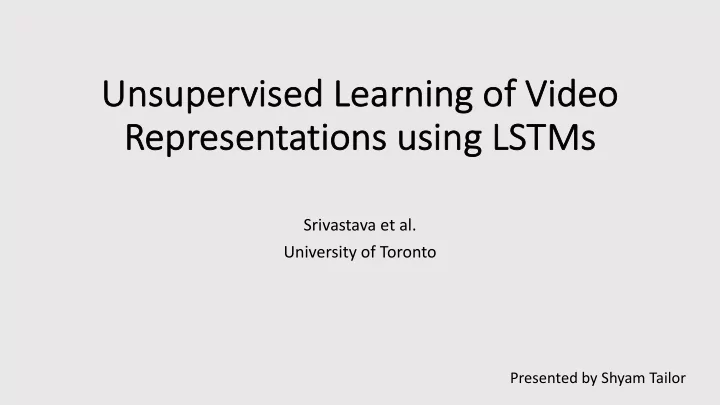

Unsupervised Le Learning of Video Representations using LS LSTMs Srivastava et al. University of Toronto Presented by Shyam Tailor
The Overall Idea • Take a sequence of images and encode into a fixed size latent representation • Decode latent representation back into a target sequence
What Should The Latent Representation Encode? • Significant redundancy between frames • Three things that seem reasonable to encode: • Background • Objects • Motion
The Target Sequence Predicting the future Reconstruction ( in reverse! )
Why Reverse The Reconstruction? • Idea – latent representation is like a stack • Encoder pushes on and decoder pops off Encoder Decoder
Future Prediction • To do well the latent representation must encode the objects and how they’re moving • Note: this puts subtly different requirements on the encoder!
Conditioning the Decoder • A small detail – the decoder can be conditioned on the previously generated frame • Not really important but improves results a little.
Combining the Tasks • The two tasks alone aren’t good enough L • Why? • Reconstruction requires memorisation but doesn’t require encoding to be useful to predict future • Future prediction doesn’t incentivise keeping frames from the past
An Experiment with MNIST
Trying Natural Images
Zooming In
“Designing a loss function that respects our notion of visual similarity is a very hard problem” True… Let’s return to this at the end
Seeding a Classifier with the Encoder • Going to do human action recognition on some video datasets (UFC-101, HMDB- 51). • Is initializing with the encoder weights better than starting from random? • What if the encoder is trained on unrelated videos?
Results of Pretraining • Encoder features transfer well and yield accuracy improvements • Especially pronounced with a small dataset • Using random YouTube videos doesn’t affect accuracy!
Does the Encoding Really Have a Concept of Motion? • Instead of using the RGB images, it’s possible to train on the optical flow vectors instead • Pretraining significantly less effective in this regime. Photo credit: Mathworks
Authors’ Conclusions • Great qualitative performance on the moving MNIST dataset – but falls over on natural images • Nevertheless pretraining for natural images seems to have some effect • It seems a stronger notion of optical flow is obtained
Discussion: How do you make your frame predictions less blurry? • One idea is to use an adversarial loss. • Liang et al. 2017 tried this; their embedding was also great for pretraining on UFC-101
Discussion: Interpreting the Encoding • Is there any form of interpretability? • Examples: • Are encodings of motion, objects and background merged together or distinct? • Is it possible to extract specific objects from the encoding?
Discussion: What About Regularisation? • The authors saw no difference between pretraining on YouTube and the activity recognition – how much does domain matter ? • Is it possible to use a VAE by reframing the problem? • See “Learning to Decompose and Disentangle Representations for Video Prediction” by Hsieh et al.
References 1. Liang, Xiaodan, et al. "Dual motion GAN for future-flow embedded video prediction." Proceedings of the IEEE International Conference on Computer Vision . 2017. 2. Hsieh, Jun-Ting, et al. "Learning to decompose and disentangle representations for video prediction." Advances in Neural Information Processing Systems . 2018.
Recommend
More recommend